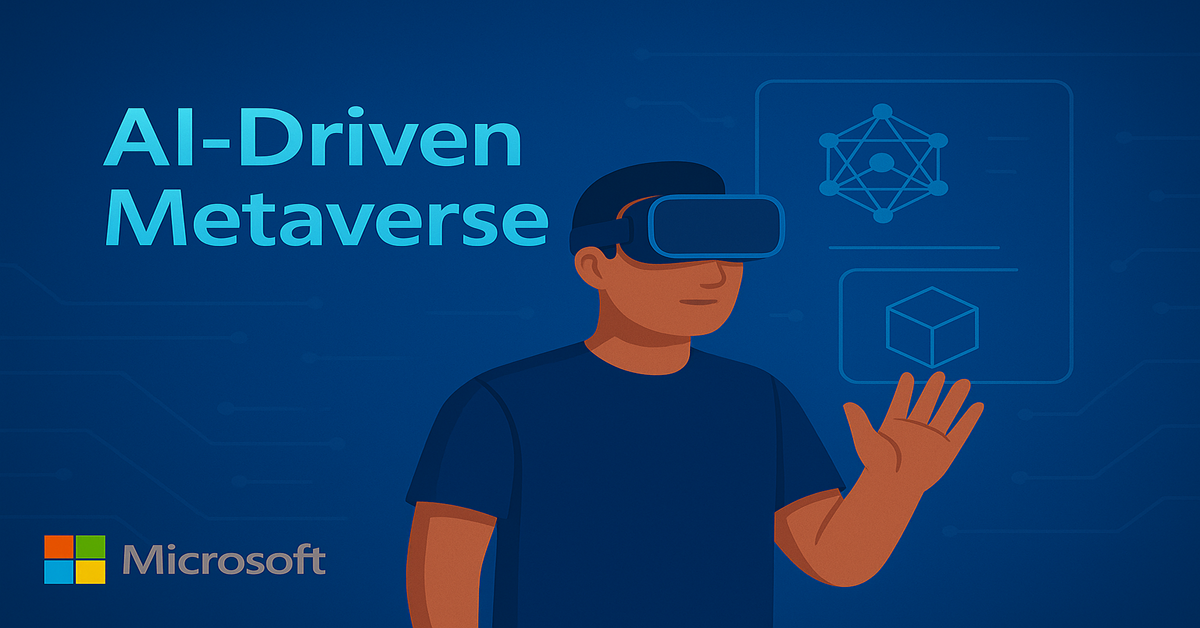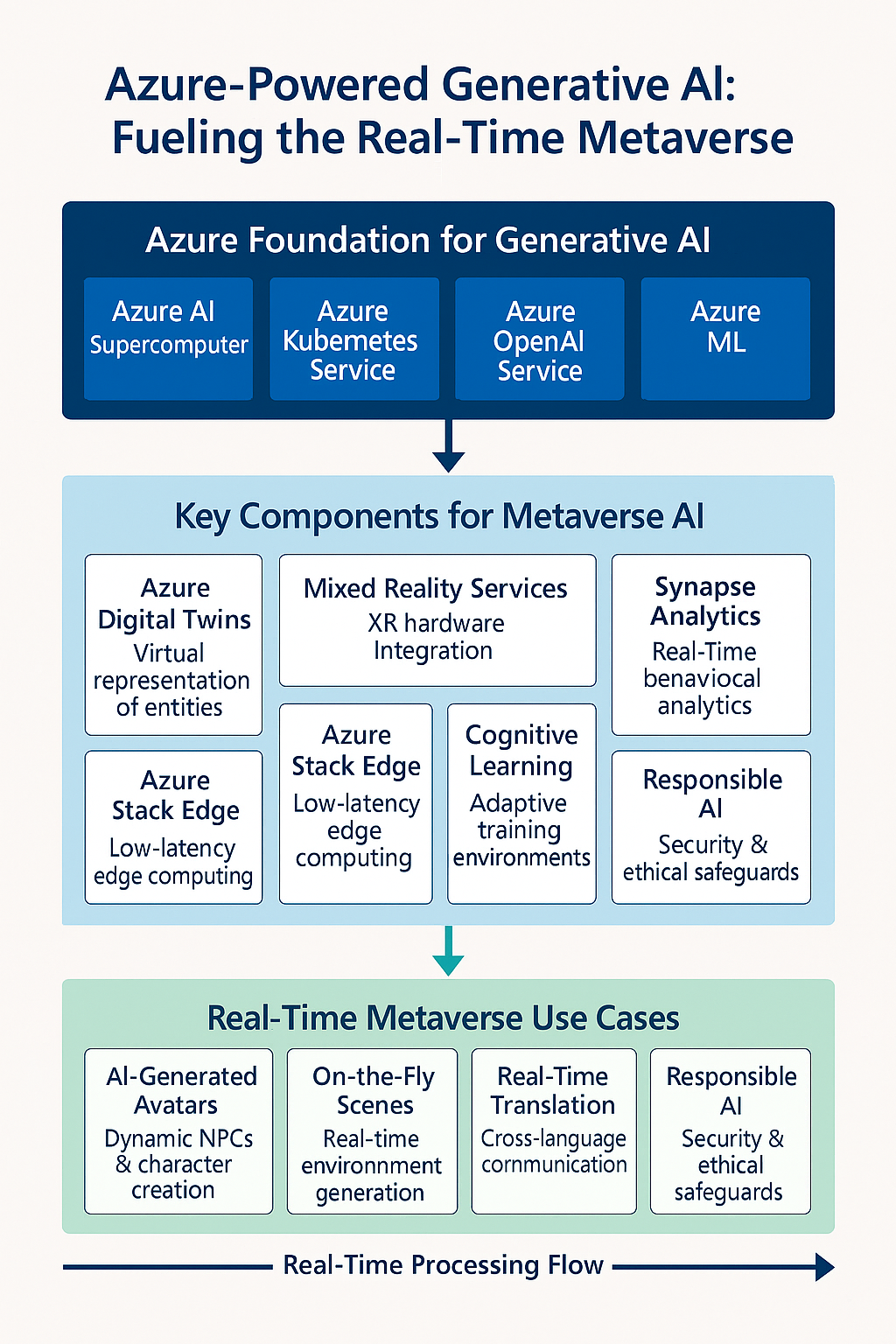Azure-Powered Generative AI: Fueling the Real-Time Metaverse
Generative AI Meets the Metaverse

Introduction
The metaverse—a collective virtual shared space built by converging virtually enhanced physical reality and physically persistent virtual worlds—is no longer a speculative vision. With the surge of interest from global tech giants, the metaverse is rapidly transitioning from concept to reality. The core of this transformation lies in generative AI, which powers real-time creation and interaction in immersive digital environments. When it comes to scaling and enabling this innovation, Microsoft Azure stands out as a frontrunner.
This article explores how Azure empowers developers, enterprises, and creators to build dynamic, real-time generative AI experiences for the metaverse and how this shapes the future of digital interaction, content generation, and spatial computing.
The Role of Generative AI in the Metaverse
Before diving into Azure’s capabilities, it's important to understand why generative AI is essential to the metaverse:
- Dynamic content creation: AI-generated environments, characters, narratives, and assets allow personalized and evolving experiences.
- Real-time interaction: Users engage in seamless, responsive virtual spaces with AI-powered NPCs, voice assistants, and story engines.
- User-generated content at scale: Instead of manually designing every element, users and developers can use AI to create infinite variations of environments, avatars, and more.
Generative AI tools like GPT models (for text), DALL·E (for images), and NeRF (for 3D scenes) enable unprecedented creative flexibility. However, such computational tasks require high-performance infrastructure—exactly what Azure provides.
Why Azure is perfect for Generative AI in the Metaverse
1. Huge Computing Power
Generative models, particularly when operating in real-time, are computationally expensive. Azure provides this through:
- Azure AI Supercomputer: Built in collaboration with OpenAI, this supercomputer is the basis for training and executing huge generative models.
- Azure Kubernetes Service (AKS): Dynamically scales AI workloads within containers—ideal for generative workloads on multiple metaverse instances.
2. Real-Time Edge AI Deployment
Latency is a deal-breaker in virtual worlds. Azure solves this via:
- Azure IoT Edge + Azure Stack Edge: Bring generative models closer to users by running AI at the edge, drastically reducing response time in immersive experiences.
- Live video and audio inference: Apply solutions such as Azure Video Analyzer and Cognitive Services to improve live interaction.
3. Azure OpenAI Service Integration
Azure offers native support for large foundation models, including:
- GPT-4: Used for conversation systems, NPC behavior, and content storytelling.
- DALL·E and Codex: For dynamically generating image assets and code snippets.
- Whisper (Speech-to-Text): Enables voice-based interaction in 3D environments.
These models can be fine-tuned or used in the cloud or at the edge.
4. AI DevOps and MLOps for Continuous Improvement
Azure Machine Learning provides complete lifecycle management for generative AI:
- Model versioning
- Data drift detection
- A/B testing in virtual environments
- Retraining based on in-world feedback
Key Components of Azure-Powered Generative AI for the Metaverse
To effectively deploy generative AI in a metaverse setting using Azure, you need several architectural components:
| Component | Function |
|---|---|
| Azure OpenAI Service | Access to large language and image models |
| Azure Digital Twins | Virtual representation of people, places, and things |
| Azure Mixed Reality Services | Integration with HoloLens and other XR hardware |
| Azure Synapse Analytics | Real-time analytics for behavior-driven content generation |
| Azure Machine Learning | Model training, fine-tuning, deployment |
| Azure Stack Edge | Brings AI inference closer to users with minimal latency |
| Azure Cosmos DB | Fast, scalable storage for metaverse data and metadata |
| Azure Cognitive Services | Speech, vision, and language understanding |
Use Cases: Azure + Generative AI in the Metaverse
1. AI-Generated Avatars and NPCs
Using GPT-4 and Azure’s Speech services, you can create lifelike non-player characters that adapt to users’ behavior, carry intelligent conversations, and evolve.
Example:
- A virtual museum guide that adjusts its tone and information depth based on user interaction history.
2. On-the-Fly Scene Generation
With DALL·E integrated into Azure, metaverse platforms can generate new scenes or landscapes based on real-time user prompts or procedural storytelling.
Example:
When a user enters "snowy forest with an invisible cabin," a new 3D scene is displayed immediately with the help of hybrid AI-image and 3D projection models.
3. Real-Time Translation in Global Spaces
Azure's Translator and Whisper models enable users in various countries to converse smoothly without language constraints.
Example:
- Two users from Japan and Brazil are having a real-time voice conversation in their native languages with AI translation in the background.
4. Generative Commerce: Personalized Virtual Shopping
Retailers can use generative AI in Azure to build unique, AI-generated storefronts or fashion pieces for each user.
Example:
- AI avatars generate a custom virtual jacket based on a user’s past style preferences and current virtual location.
5. Gamified Learning and Training
Companies use Azure’s digital twin and generative AI tools to create immersive, adaptive learning environments for employee training, simulation, and testing.
Example:
- A healthcare organization builds a VR metaverse for emergency response training, with real-time scenario generation and adaptive AI assessments.

Security and Ethics: Azure’s Guardrails for Responsible AI
The explosion of generative AI in the metaverse raises ethical questions around misinformation, IP rights, and user manipulation. Azure addresses this through:
1. Responsible AI Framework
Azure includes tools like:
- Fairlearn: Ensures models do not perpetuate bias.
- InterpretML: Improves transparency in decision-making.
- Content moderation APIs: Used to filter inappropriate or harmful AI-generated content.
2. Compliance and Governance
Azure supports over 100 compliance certifications, including:
- GDPR
- HIPAA
- ISO/IEC 27001
This ensures that AI deployments in the metaverse adhere to regional and global standards.
3. Security Features
With Azure Confidential Computing, data used in generative models remains encrypted even during processing, which is critical in metaverse environments where identity and privacy are core.
Future Outlook: Azure's Ongoing Role in Defining the Metaverse
Microsoft has made strategic investments to solidify its role in this space, including:
- Acquiring Activision Blizzard signals deeper metaverse ambitions.
- Expanding the Azure AI supercomputing infrastructure.
- Partnering with Meta, OpenAI, and NVIDIA to drive innovation in XR and AI.
As the metaverse matures from virtual social spaces to enterprise collaboration hubs, Azure will likely be the backbone, enabling secure, intelligent, and real-time experiences.
Conclusion
The future of the metaverse hinges on intelligence, interactivity, and immersion—all made possible by real-time generative AI. Microsoft Azure has emerged as a leading platform by offering a unique combination of scalable AI infrastructure, cutting-edge models, and real-time processing at the edge. Whether building dynamic avatars, designing smart digital twins, or enabling interactive education in virtual worlds, Azure delivers the reliability, flexibility, and performance required to bring those experiences to life. As businesses race to explore opportunities in the metaverse, Azure provides the tools and the strategic foundation to innovate responsibly and scale globally. Explore how Azure Cloud Services can power your generative AI and metaverse initiatives
FAQ'S
1. What is Azure OpenAI Service, and how does it enable generative AI?
Azure OpenAI Service gives developers access to sophisticated language models such as GPT-4 and DALL·E to create applications that produce text, images, and code. These features play a critical role in the development of dynamic and interactive metaverse experiences.
2. How does generative AI augment real-time metaverse experiences?
Generative AI makes possible the generation of realistic avatars, rich worlds, and reactive interactions in real-time, more engaging and tailored virtual experiences.
3. How are some real-world applications of Azure-based generative AI within the metaverse?
Companies are using Azure's generative AI to power customer support automation, create personalized content, and create AI-based virtual assistants, promoting user engagement within virtual environments.
4. What measures does Azure take to assure responsible use of generative AI in metaverse applications?
Microsoft has tools and guidelines within Azure OpenAI Service to ensure responsible use of AI, such as content moderation and usage policies, to ensure ethical deployment for metaverse scenarios.
5. Can Azure's generative AI models be tailored to individual metaverse applications?
Yes, Azure supports fine-tuning its AI models to fit particular use cases, allowing developers to customize functionalities for distinctive metaverse experiences.

